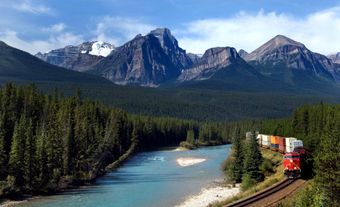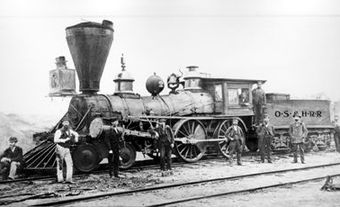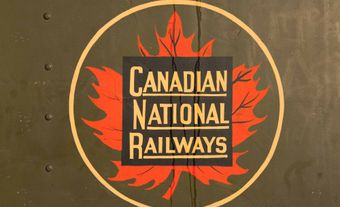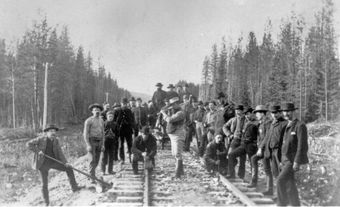The Canadian Pacific Railway (CPR) was founded in 1881. Its primary purpose was to construct a transcontinental railway. It completed the railway in 1885. For the first time in Canadian history, Canadians and Canadian goods could travel from east to west in a short period of time. This was revolutionary. Canadian Pacific Railway, known as CP today, is one of Canada’s most significant companies. It remains one of the most important systems of transportation for the Canadian economy. Every day, CP transports countless varieties of commodities across the nation.
(This article is a plain-language summary of the CPR. If you are interested in reading about this topic in more depth, please see our full-length entry, Canadian Pacific Railway.)

Indigenous Lands
To ensure that Canada could survive as a nation, the government of Canada had to connect the country from the Atlantic to the Pacific. To do so, it was vital for them to secure land on the Prairies (see History of Settlement in the Canadian Prairies). The Prairies were the “gateway to the West.” The Prairies however were the home of many First Nations. To obtain this land, the federal government negotiated a series of treaties with these groups. These are known as the Numbered Treaties. Treaties No. 1 to 7 were negotiated between 1871 and 1877. The government made many promises to First Nation peoples. It promised them reserve land. It promised to give them farming supplies. It promised to give them cash payments. It promised to give them tools. It promised to provide medical care. It promised to provide education. And it promised them hunting and fishing rights. These are only some of the promises that were made. The Numbered Treaties are extremely controversial. The legacy of the Numbered Treaties is a tragic one for First Nation peoples. The Numbered Treaties have impacted First Nation peoples culturally, legally and economically.
Building the Transcontinental Railroad
In 1878, Prime Minister John A. Macdonald promised to complete the transcontinental railway. The railway was very important for the success of Canada as a nation. It would transport immigrant settlers to the Prairies and British Columbia. It would transport goods from west to east and east to west. And it would stop Americans from laying claim to the Prairies.
The CPR faced two very big problems as soon as it was founded. It did not have enough money. And it did not have enough workers. The government solved the first problem. It provided millions of dollars to the CPR. The second problem was solved by employing Chinese workers. The CPR employed approximately 15,000 Chinese workers. They were the primary workers who built the railway in British Columbia. Hundreds died working in unsafe conditions. The railway was completed in 1885 (see The Last Spike). Canada was connected from sea to sea. After it was built, the government taxed Chinese immigration to stop Chinese people from coming to Canada (see Chinese Head Tax in Canada).
After the completion of the transcontinental the CPR continued to build railway lines. It built a line to North Dakota. It also constructed branch lines throughout the prairies to connect farming communities to the cities. Many of these have fallen out of use.
CPR’s Other Endeavors
The CPR not only connected Canada from east to west. It also connected Canada to the entire world. Its steamships ventured to many countries starting in the last few decades of the 19th century. In addition to international shipping, the CPR also got involved in the hotel business and the mining business. One of its most famous hotels was the Chateau Lake Louise. CPR also organized an airline in 1942.
CPR: Competition and Survival
The CPR began to face competitors starting in the late 19th century. Its greatest competitor was the Canadian National Railway (CN). The Government of Canada created the CNR in 1917-23. Like the CPR it was also in the telegraph and steamship business. And like the CPR, branded as CP today, the CN still exists today. The CPR, however, will always be remembered as the first to connect Canada.

 Share on Facebook
Share on Facebook Share on X
Share on X Share by Email
Share by Email Share on Google Classroom
Share on Google Classroom



